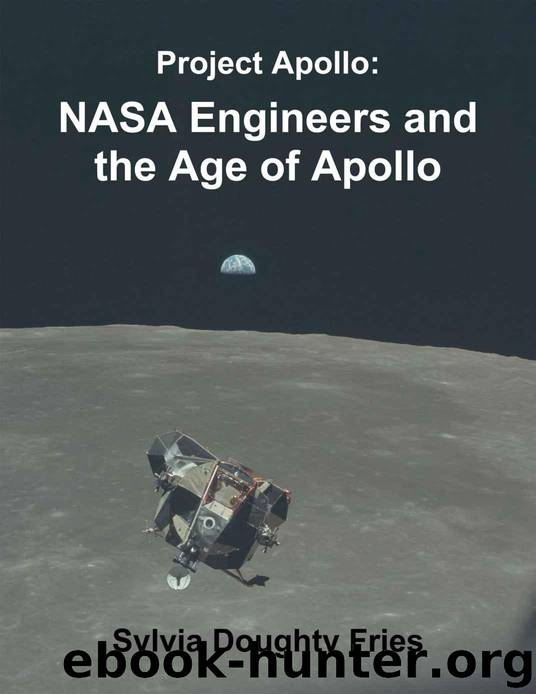Project Apollo: NASA Engineers and the Age of Apollo by Fries Sylvia Doughty

Author:Fries, Sylvia Doughty [Fries, Sylvia Doughty]
Language: eng
Format: mobi
Publisher: Cia Publishing
Published: 2012-09-12T04:00:00+00:00
Chapter 4 - Journeys
“Winning isn't everything. It's the only thing.”
Vince Lombardi, Coach, Green Bay Packers, 1959-1967
One of the many lessons of World War II was that air supremacy could be the linchpin of military victory. As nuclear warheads emerged as the "ultimate" weapon of the Cold War, the development of guided land- and sea-based ballistic missiles took on a special urgency in the U.S. military establishment. Not yet chastened by the protracted land warfare of Vietnam or the complexities of undeclared local warfare in the Middle East, most strategists assumed that strategic security would go to those who commanded the skies. Impelled by the sheer weight of its role in the allied victory over the Axis powers into an international arena divided into the "free world" and "iron curtain" countries, the United States belatedly entered the race to conquer space.
But what did it mean to conquer space? A nation's ability to send guided missiles into space, or to orbit objects of whatever size and function, served as an ominous announcement to a contentious world that the ultimate penalty for "aggression" might be close to unthinkable. Was there no peaceful purpose to which we might put the capacity to loft objects into space, to view the heavens-and Earth-with unprecedented visual clarity and perspective?
American scientists, too, had a strategic interest in space. Having tasted the brew served up by military patrons during the national "emergency" and the Manhattan Project, the scientific community sought to remain at the table with an ongoing menu of government-funded "basic" research. Yet consciences had been troubled by the uses to which science had been put in "winning" the surrender of Japan; many in the scientific fraternity were eager to explore the next frontier of space under civilian, rather than military, support.1
Thus it was that, while the NACA (later NASA) and military engineers began to transfer the new technologies of hypersonic flight and ballistic missiles to vehicles that could lift ever heavier payloads into orbit (even sending some of those payloads on interplanetary trajectories), the payloads themselves were parceled among [90] competing interests. Among those interests, shrouded in ideological assumptions, were the proponents of "manned space flight" and of "space science"-or science in space. The former combined the heroic, romanticized aura of human flight, inherited from pioneer aviation days, with the new romance of space travel into exotic and alien realms. The romance of aviation knew few geographic boundaries, but the romance of space travel was largely an import from Europe, never wholly adopted by a country whose ideology presupposed that its own wondrous landscapes, its own pluralistic culture and institutions, and its own free-wheeling politics constituted the only last frontier that mattered. The notion that the survival of democracy required an expanding frontier (a notion easily associated with the ignominious attempt of nineteenth century Europeans to extend cultural and political hegemony over the rest of the world) would come back to haunt advocates of expanding the space frontier as opponents of costly manned space programs remained indifferent to appeals to an American "manifest destiny" in space.
Download
This site does not store any files on its server. We only index and link to content provided by other sites. Please contact the content providers to delete copyright contents if any and email us, we'll remove relevant links or contents immediately.
| Automotive | Engineering |
| Transportation |
Whiskies Galore by Ian Buxton(41509)
Introduction to Aircraft Design (Cambridge Aerospace Series) by John P. Fielding(32876)
Small Unmanned Fixed-wing Aircraft Design by Andrew J. Keane Andras Sobester James P. Scanlan & András Sóbester & James P. Scanlan(32558)
Craft Beer for the Homebrewer by Michael Agnew(17917)
Turbulence by E. J. Noyes(7682)
The Complete Stick Figure Physics Tutorials by Allen Sarah(7120)
Kaplan MCAT General Chemistry Review by Kaplan(6568)
The Thirst by Nesbo Jo(6421)
Bad Blood by John Carreyrou(6260)
Modelling of Convective Heat and Mass Transfer in Rotating Flows by Igor V. Shevchuk(6216)
Learning SQL by Alan Beaulieu(6012)
Weapons of Math Destruction by Cathy O'Neil(5805)
Man-made Catastrophes and Risk Information Concealment by Dmitry Chernov & Didier Sornette(5626)
Digital Minimalism by Cal Newport;(5355)
Life 3.0: Being Human in the Age of Artificial Intelligence by Tegmark Max(5166)
iGen by Jean M. Twenge(5143)
Secrets of Antigravity Propulsion: Tesla, UFOs, and Classified Aerospace Technology by Ph.D. Paul A. Laviolette(4907)
Design of Trajectory Optimization Approach for Space Maneuver Vehicle Skip Entry Problems by Runqi Chai & Al Savvaris & Antonios Tsourdos & Senchun Chai(4833)
Electronic Devices & Circuits by Jacob Millman & Christos C. Halkias(4728)
